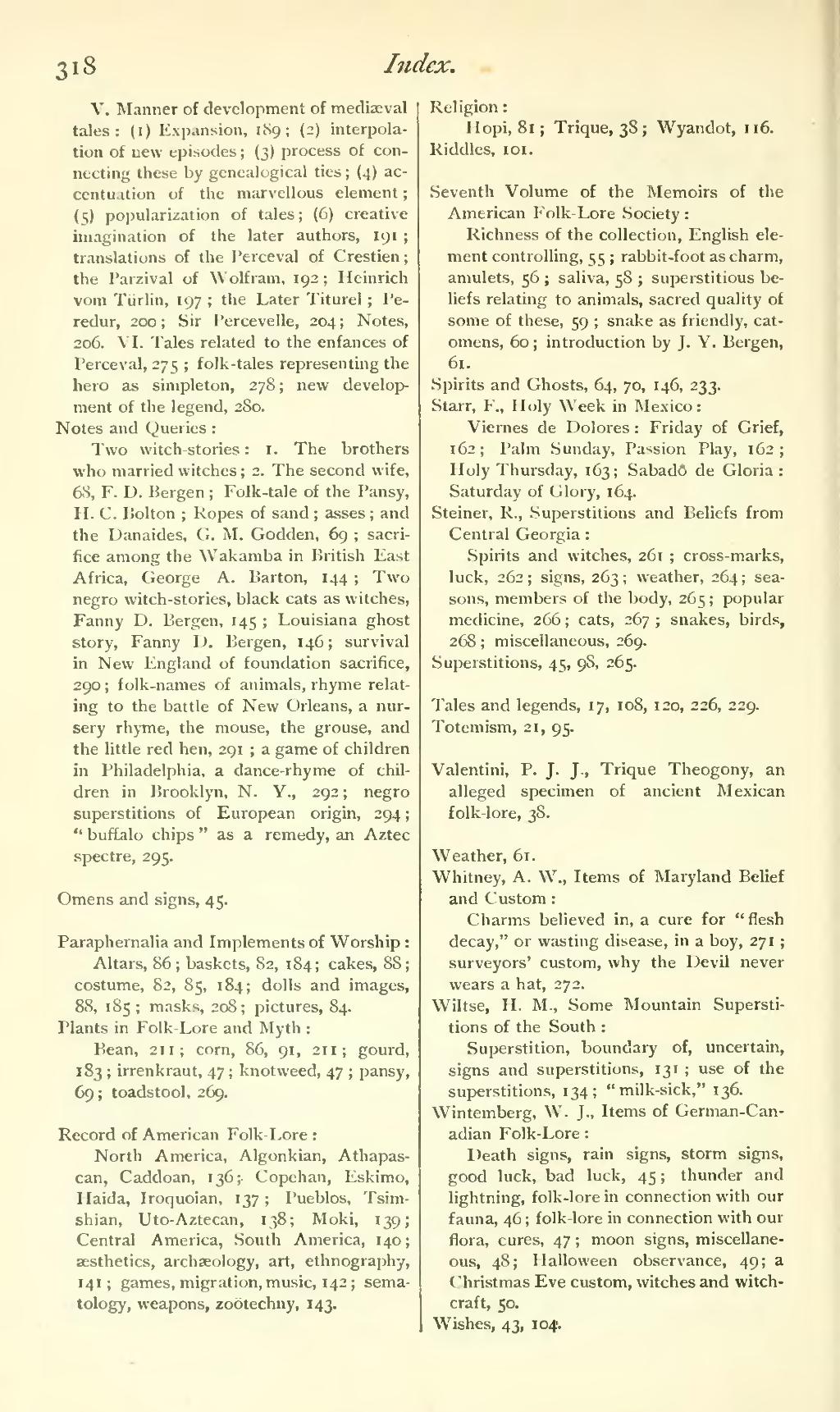iS
��Index.
��V. Manner of development of medieval tales: (i) Expansion, 1S9; (2) interpola- tion of uew episodes ; (3) process of con- necting these by genealogical ties ; (4) ac- centuation of the marvellous element ; (5) popularization of tales; (6) creative imagination of the later authors, 191 ; translations of the Perceval of Crestien ; the Parzival of Wolfram, 192 ; Heinrich vom Tiirlin, 197 ; the Later Titurel ; Pe- redur, 200; Sir Percevelle, 204; Notes, 206. VI. Tales related to the enfances of Perceval, 275 ; folk-tales representing the hero as simpleton, 278 ; new develop- ment of the legend, 280. Notes and Queries :
Two witch-stories : 1. The brothers who married witches ; 2. The second wife, 68, F. D. Bergen ; Folk-tale of the Pansy, H. C. Bolton ; Ropes of sand ; asses ; and the Danaides, G. M. Godden, 69 ; sacri- fice among the Wakamba in British East Africa, George A. Barton, 144 ; Two negro witch-stories, black cats as witches, Fanny D. Bergen, 145 ; Louisiana ghost story, Fanny D. Bergen, 146; survival in New England of foundation sacrifice, 290 ; folk-names of animals, rhyme relat- ing to the battle of New Orleans, a nur- sery rhyme, the mouse, the grouse, and the little red hen, 291 ; a game of children in Philadelphia, a dance-rhyme of chil- dren in Brooklyn, N. Y., 292 ; negro superstitions of European origin, 294 ; " buffalo chips " as a remedy, an Aztec spectre, 295.
Omens and signs, 45.
Paraphernalia and Implements of Worship : Altars, 86 ; baskets, 82, 184; cakes, 88; costume, 82, 85, 184; dolls and images, 88, 185; masks, 208; pictures, 84. Plants in Folk-Lore and Myth :
Bean, 211; corn, 86, 91, 211; gourd, 183 ; irrenkraut, 47 ; knotvveed, 47 ; pansy, 69 ; toadstool, 269.
Record of American Folk-Lore :
North America, Algonkian, Athapas- can, Caddoan, 136; Copehan, Eskimo, Haida, Iroquoian, 137 ; Pueblos, Tsim- shian, Uto-Aztecan, 138; Moki, 139; Central America, South America, 140 ; aesthetics, archaeology, art, ethnography, 141 ; games, migration, music, 142 ; sema- tology, weapons, zobtechny, 143.
��Religion :
Hopi, 81; Trique, 38 ; Wyandot, 116. Riddles, 101.
Seventh Volume of the Memoirs of the American Folk-Lore Society :
Richness of the collection, English ele- ment controlling, 55 ; rabbit-foot as charm, amulets, 56 ; saliva, 58 ; superstitious be- liefs relating to animals, sacred quality of some of these, 59 ; snake as friendly, cat- omens, 60 ; introduction by J. Y. Bergen, 61.
Spirits and Ghosts, 64, 70, 146, 233.
Starr, F., Holy Week in Mexico:
Viernes de Dolores : Friday of Grief, 162 ; Palm Sunday, Passion Play, 162 ; Holy Thursday, 163; Sabado de Gloria: Saturday of Glory, 164.
Steiner, R., Superstitions and Beliefs from Central Georgia :
Spirits and witches, 261 ; cross-marks, luck, 262 ; signs, 263 ; weather, 264 ; sea- sons, members of the body, 265 ; popular medicine, 266 ; cats, 267 ; snakes, birds, 268 ; miscellaneous, 269.
Superstitions, 45, 98, 265.
Tales and legends, 17, 108, 120, 226, 229. Totemism, 21, 95.
Valentini, P. J. J., Trique Theogony, an alleged specimen of ancient Mexican folk-lore, 38.
Weather, 61.
Whitney, A. W., Items of Maryland Belief and Custom :
Charms believed in, a cure for "flesh decay," or wasting disease, in a boy, 271 ; surveyors' custom, why the Devil never wears a hat, 272.
Wiltse, H. M., Some Mountain Supersti- tions of the South :
Superstition, boundary of, uncertain, signs and superstitions, 131 ; use of the superstitions, 134; "milk-sick," 136.
Wintemberg, W. J., Items of German-Can- adian Folk-Lore :
Death signs, rain signs, storm signs, good luck, bad luck, 45 ; thunder and lightning, folk-lore in connection with our fauna, 46; folk-lore in connection with our flora, cures, 47 ; moon signs, miscellane- ous, 48; Halloween observance, 49; a Christmas Eve custom, witches and witch- craft, 50.
Wishes, 43, 104'.
�� �
